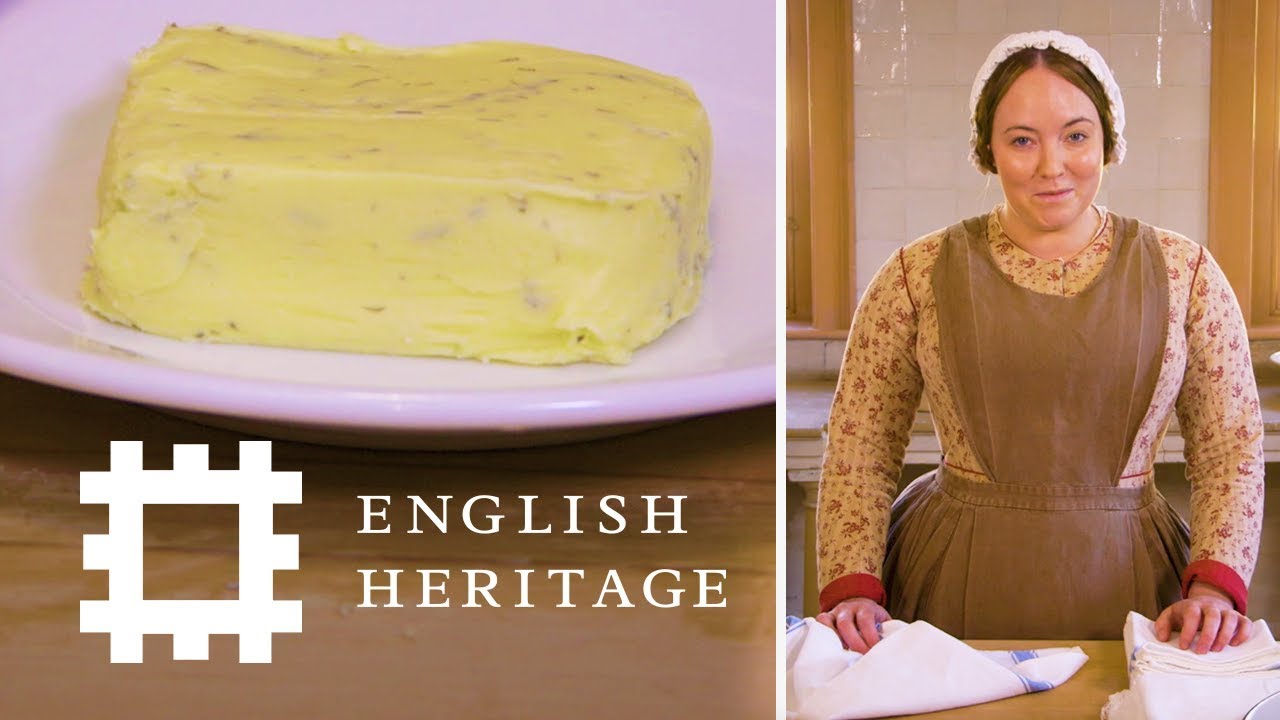Introducing Miss Fanny Cowley, the dairy maid of Audley End House, Essex, England! This is a recreation from English Heritage, a national organization dedicated to protecting and preserving the past.
The kitchens at Audley End House use a lot of butter – around 3-4lbs a day. Today, Mrs Crocombe pays a visit to the dairy as she requires some butter with herbs. English Heritage is a charity, working to preserve the story of England and bring it to life.
English Heritage cares for over 400 historic monuments, buildings and places – from world-famous prehistoric sites to grand medieval castles, from Roman forts on the edges of an empire to a Cold War bunker.

Thank you for watching. Here are some answers to questions you might have about this episode.
HOW WAS HERB BUTTER USED? Herb butter was used for lots of things. Anything where you might want both butter and a herby hit. It wasn’t really consumed as a snack, but as part of meals and is useful to have as an emergency store cupboard item. Uses include spreading on cold toast, bread croutes as part of the savoury course (at the end of the meal: canapés didn’t quite exist yet), served on the side with fish or meat (ergo making a sauce), or with potatoes or hot vegetables. It could also be smeared under the skin of a chicken or poussin (i.e. you insert a hand up between the flesh and the skin and rub the butter in, then when roasted in an oven it sort of self-bastes). In a modern context it is excellent with pasta!
WHAT DOES SCALDING MEAN? Fanny soaks everything she uses in boiling water before use. It disinfects it. The Victorians were well aware of best practice in food hygiene – they may not have identified germs as such, but they knew the consequences of poorly cleaned kitchen equipment – a particular problem when using wooden implements which are prone to going mouldy.
WHAT’S THE LARGE CHURN NEXT TO HER? The larger churn takes several gallons of milk and is a slightly different design. Although we’re not completely certain, there is no evidence of another, bigger dairy at Audley End (for example at the Home Farm), so we think that it fell to Fanny to produce all of the substantial quantity of butter which was used in the kitchens. There was even excess sometimes – there are records of labels being printed for selling it.
WHAT HAPPENS TO ALL OF THE BUTTERMILK? There were various uses for buttermilk, including stain removal (good for ink) and in cooking. Some was sold to locals.
WHAT HAPPENED TO THE MILK LEFT AFTER THE CREAM HAD BEEN SKIMMED OFF? Skimmed milk, as it was known, was a byproduct of butter making. It was usually sold at low cost to the estate workers and villagers.
DID THEY MAKE CHEESE? Not at Audley End in the 1880s. Essex cheese had quite a bad reputation at the time!
HOW DOES SHE MOULD IT? Using a butter pat or mould, well-soaked in water.
IT IS SALTED? Most of the butter was salted (it was rather saltier than modern day salted butter, as the salt was a preservative as well as there for flavour). Unsalted butter was known as sweet butter and is occasionally called for in contemporary recipes.
WAS THAT COW REALLY CALLED LEMON LEAF? Yes, Lord Braybrooke was very fond of his herd of Jerseys, for which he and the associated staff won prizes. They all had fanciful names: Spermlight and Gossamer were two of the others. Their names were recorded in the herd book, which also contained details of daily milk yields per cow and percentage of cream.

